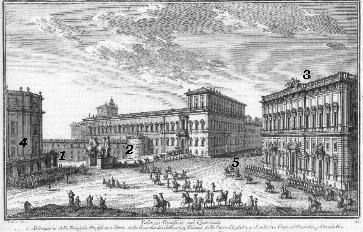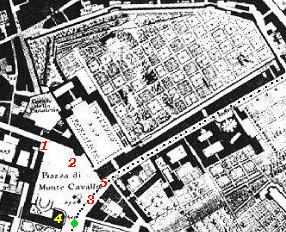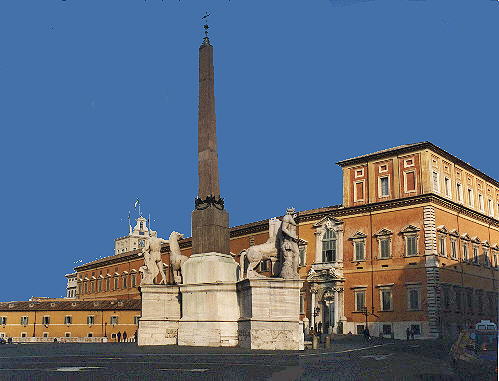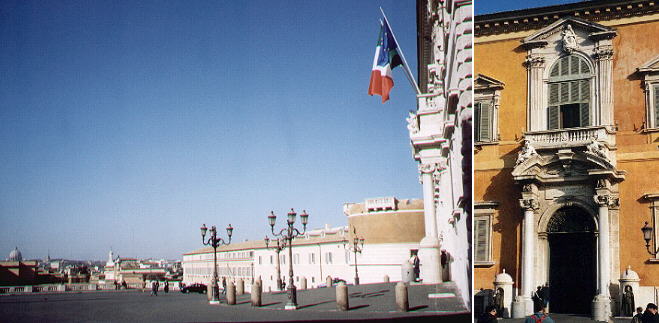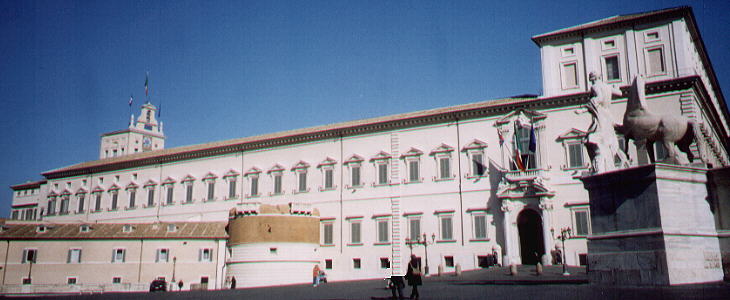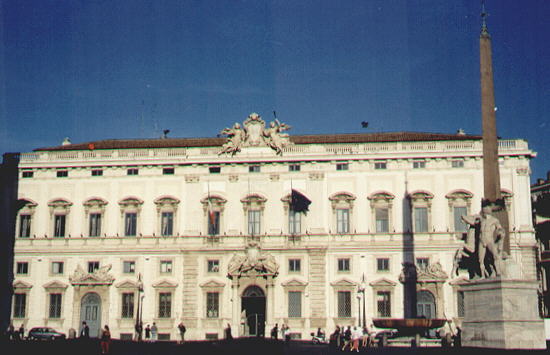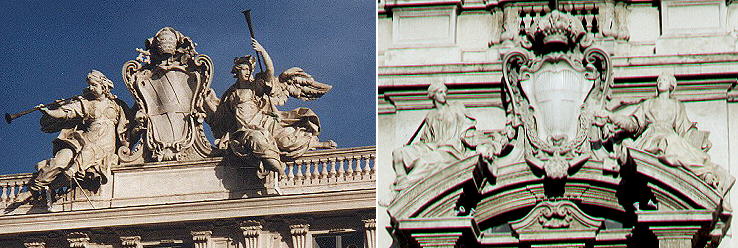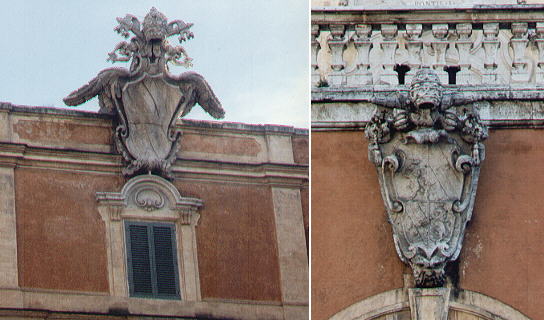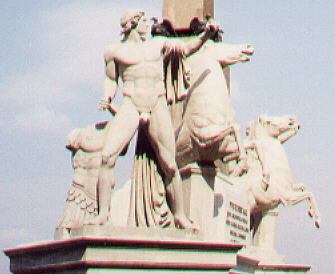  Palazzo Pontificio sul Quirinale (Book 4) (Map B2) (Day 3) (View B7) (Rione Trevi) (Rione Monti) In this page: The plate by Giuseppe Vasi Today's view The Palace Palazzo della Consulta The stables (scuderie) The obelisk The Plate (No. 61)
Book 4 opens with the Palace of the Pope on Monte Cavallo (cavallo=horse), what is now called the Quirinal Palace. This was where the Pope usually lived. On the right the Palazzo della Consulta, being la Consulta (consulta=advice) a Tribunal. The view is taken from the green dot in the small 1748 map here below. In the description below the plate Vasi made reference to: 1) Houses for the servants of the Pope; 2) Tower of the Swiss Guard; 3) Palazzo della Consulta; 4) Scuderia e Corpo di Guardia (stables and barracks); 5) Via Pia (the street opened by Pius IV and leading to Porta Pia). The dotted line in the small map delineates the border between Rione Trevi (left) and Rione Monti (right).
The main changes relate to the obelisk erected among the Horse Tamers statues (by Pius VI and Pius VII) and to the levelling of the square (by Pius IX). The Palace
The Palace was started by Gregorius XIII and completed by Maderno under Paulus V. Urbanus VIII buiilt
a round tower to protect its entrance, but this defense proved insufficient in February 1798 and in July 1809
when the French assaulted the palace and captured the pope. The Palace after 1870 became the Royal Palace of the
King of Italy and is now the Palace of the President of the Italian Republic. The coat of arms of the pope
has been removed (on the balcony there is now a small coat of arms of the Savoia family), but the heraldic
symbols of Paulus V are still evident. His eagle and his dragon are additional sentinels. The palace enjoys
a very fine view over St. Peter's.
The image below shows the palace after it has been repainted with those clear colours it had in the XVIIIth century.
Palazzo della Consulta
The palace is still used for Law purposes. It now hosts the Constitutional Court of the Italian Republic.
Built by Ferdinando Fuga under Clemens XII it is topped by a large coat of arms similar to the one of
Fontana di Trevi. Its entrance did not have a coat of arms, so the Kings of Italy who set their residence in nearby Palazzo del Quirinale took the occasion to put their coat of arms.
The Stables
The square is closed by a long low building: the stables. Clemens XII and Pius IX (twice) put on it their coats of arms. The building is now used for exhibitions and it has been repainted (click here to see its new appearance).
The monument in the center is made of three elements: a) a fountain with an antique granite basin which was in front of
S. Maria Liberatrice in the Forum and was moved here by Pius VII; b)
two colossal statues of the horse tamers Castor and Pollux after whose horses originally the piazza derived its name (works of the imperial age
copied from originals by Lysippus, notwithstanding the inscriptions which make reference to Phidia and
Praxiteles); they were in the nearby Constantine's Baths and they were moved here by Sixtus V, who put
them side to side (see the plate); Pius VI gave them a different orientation when he erected c) the obelisk
which originally stood in front of the Mausoleum of Augustus
(to see all the obelisks of Rome click here).
Next plate in Book 4: Palazzo Rospigliosi Next step in Day 3 itinerary: Giardino Pontificio Next step in your tour of Rione Trevi: Giardino Pontificio sul Quirinale Next step in your tour of Rione Monti: Chiesa e Monastero di S. Andrea al Quirinale  or to Book 4 or to
The Coats of Arms of the Popes or
to My Home Page on Baroque Rome or to
My Home Page on Rome in the footsteps of an XVIIIth century traveller or to Book 4 or to
The Coats of Arms of the Popes or
to My Home Page on Baroque Rome or to
My Home Page on Rome in the footsteps of an XVIIIth century traveller
|
All images © 1999 - 2003 by Roberto Piperno. Write to romapip@quipo.it

